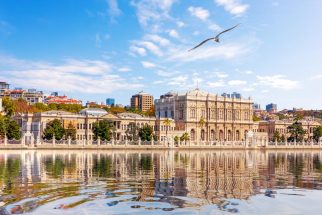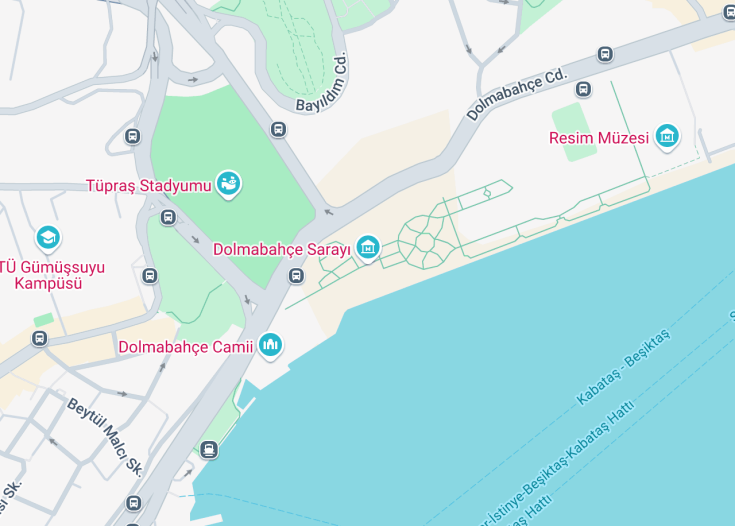Overlooking the Bosphorus, the Dolmabahçe Palace was the amazing residence of the last Ottoman sultans. It has an area of 45,000 m2 (11.1 acres), and contains 285 rooms, 46 halls, 6 baths (hamam) and 68 toilets. Due to the intersection of styles (Baroque, Rococo, Neoclassical and traditional Ottoman style), the grandiose luxury of the furnishings and the materials used, the palace appears as a miniature Versailles that is worth a visit.
You will need at least 2 to 3 hours to have a complete tour because the Dolmabahçe Palace is a huge complex with a lot of things to see.
The visit is broken into four parts: Selamlik, Hareem, Clock Museum and Glass Pavillion. The most important and impressive parts are the first two.
Dolmabahçe Palace: A Regal Residence
Dolmabahçe Palace stands as a stunning testament to the grandeur of 19th-century Ottoman architecture, making it a must-visit destination in Istanbul, Turkey. This opulent palace not only served as the main administrative center of the Ottoman Empire from 1856 to 1922 but also captivates with its eclectic European styles blended with traditional Ottoman aesthetics. It boasts an extravagant interior, including the grand Ceremonial Hall, equipped with a 4.5-ton chandelier, and rooms filled with antique furniture, decorative arts, and paintings that speak volumes about the opulent lifestyle of the era. Dolmabahçe is not just culturally enriching but also offers breathtaking views of the Bosphorus Strait, enhancing its appeal to tourists. The palace’s historical significance is peaked as it was the last residence where Mustafa Kemal Atatürk, the founder of modern Turkey, spent his final years, making it a poignant place for not only Turkish nationals but also global admirers of history.
Discover the wonders of Dolmabahçe Palace
Visitors to Dolmabahçe Palace are treated to a variety of attractions and activities that delve into Turkey’s rich history and artistic heritage. The Harem section, once home to the sultan’s family, showcases private apartments that provide insight into family life in the Ottoman court.
Guided Tours
Engage with the palace more meaningfully through comprehensive guided tours available in multiple languages. These tours provide context to the lavish decorations and intricate architectural details, enriching the visitor experience.
Exhibitions
Periodic exhibitions highlight certain aspects of the Ottoman Empire and its cultural evolution, bringing an educational twist to your visit. These exhibitions are beautifully curated to enhance understanding of the empire’s legacy.
The world’s largest Bohemian crystal chandelier
An extraordinary feature of Dolmabahçe Palace is the world’s largest Bohemian crystal chandelier in the grand Ceremonial Hall. Gifted by Queen Victoria in the 19th century, this magnificent chandelier weighs approximately 4.5 tons and includes 750 lamps. This stunning piece not only adds immense opulence to the decor but also serves as a focal point that draws visitors from around the globe. Its presence is a testament to the international relations of the Ottoman Empire at the time and adds a unique historical layer to the grandeur exhibited within the palace walls.
Discover the Splendor of Dolmabahçe Palace
Ideal for history enthusiasts, architecture lovers, and culture seekers, Dolmabahçe Palace is a must-visit destination that promises a deeply enriching experience. Whether you’re a solo traveler eager to delve into the Ottoman Empire’s history, or a family looking to explore the grandeur of Istanbul’s palatial landscapes, Dolmabahçe Palace caters to all. Prepare to be mesmerized by its stunning architecture, intricate interiors, and the compelling stories that echo through its halls.
Optimal Times for a Palace Visit
Visiting Dolmabahçe Palace during the spring (April to June) or fall (September to November) is highly recommended. These months offer comfortable weather, fewer crowds, and the lush surroundings of the palace gardens in full bloom or in the vibrant colors of fall.
Special Events
Consider planning your visit during the annual cultural festival, which typically takes place in May. This event features concerts, exhibitions, and special tours, providing a unique way to experience the palace’s historic atmosphere.
Accessibility and Visitor Information
Understanding the site’s accessibility and visitor limitations ensures a smooth and enjoyable visit.
Accessibility
Dolmabahçe Palace is partially wheelchair accessible. The main entrance, gardens, and the first floor of the palace are equipped with ramps and lifts. However, some areas remain inaccessible due to historic preservation restrictions.
Limitations
- Camera Use: Photography is not allowed inside the palace.
- Bag Restrictions: Large bags and backpacks are not allowed inside and must be stored at the entrance.
Notes to Visitors
- Wearing comfortable shoes is advised as there is considerable walking involved.
- Guided tours are available in multiple languages; however, booking in advance is recommended.
- Be prepared for occasional waiting times, especially during peak tourism seasons.
General Information
Everything you need to know for your visit to Dolmabahçe Palace.
Location
Nearby landmarks include the Istanbul Modern Art Museum and Besiktas Market. Easily accessible by public transport or taxi.
Address: Visnezade Mah. Dolmabahçe Cd., Besiktas, Istanbul
Opening Hours
Open from 09:00 AM to 06:00 PM. Closed on Mondays and national holidays.
How to Reach Dolmabahçe Palace
By Car
Dolmabahçe Palace is easily accessible by car with several parking options available nearby.
| Route | Distance | Travel Time |
|---|---|---|
| From Taksim Square | 3 miles (5 km) | 10 minutes |
| From Sultanahmet | 5 miles (8 km) | 15 minutes |
| From Kadikoy | 12 miles (19 km) | 25 minutes |
By Public Transit
Accessible via bus and ferry services, with stops within walking distance to the entrance.
| Route from | Service type | Travel Time |
|---|---|---|
| Levent | Bus | 20 minutes |
| Üsküdar | Ferry + Bus | 25 minutes |
Nearby Attractions
- Besiktas Market – 0.5 miles (0.8 km)
- Istanbul Modern Art Museum – 1 mile (1.6 km)
- Taksim Square – 2 miles (3.2 km)
- Sultanahmet District – 5 miles (8 km)
- Galata Tower – 2.5 miles (4 km)
- Spice Bazaar – 4 miles (6.4 km)
- Topkapi Palace – 5 miles (8 km)
- Grand Bazaar – 5.5 miles (8.9 km)
- Suleymaniye Mosque – 5 miles (8 km)
- Chora Church – 7 miles (11.3 km)
- Princes’ Islands Ferry Dock – 6 miles (9.7 km)
- Kadikoy District – 12 miles (19.3 km)
What is the historical significance of Dolmabahçe Palace?
Can you describe the architectural style of Dolmabahçe Palace?
What are the major attractions within Dolmabahçe Palace?
What types of collections can be seen at Dolmabahçe Palace?
Are there guided tours available in Dolmabahçe Palace?
How long does it typically take to tour Dolmabahçe Palace?
What conservation efforts are in place for Dolmabahçe Palace?
What is the best season to visit Dolmabahçe Palace?
Are photography and video recording allowed inside Dolmabahçe Palace?
Is Dolmabahçe Palace accessible for visitors with disabilities?
What are the cultural norms to be aware of when visiting Dolmabahçe Palace?

Is the Dolmabahçe Palace in Istanbul worth visiting?
The Dolmabahçe Palace, with its stunning architecture and deep historical significance, holds considerable attraction for those touring Istanbul. Its lavishly decorated interior, featuring crystal chandeliers and handcrafted mosaic tiles, showcases the opulence of the late Ottoman era. Furthermore, the Palace is not just a feast for the eyes but also a substantial bearer of history, having served as the administrative center of the Ottoman Empire during its final years and later becoming Ataturk’s residence.
However, it might not appeal as much to tourists who prefer more interactive or engaging historical sites, as the tours can be quite rigid and crowded. For those looking for a less conventional experience, places like the nearby Istanbul Modern might provide an alternative cultural insight into Turkey’s rich legacy.










